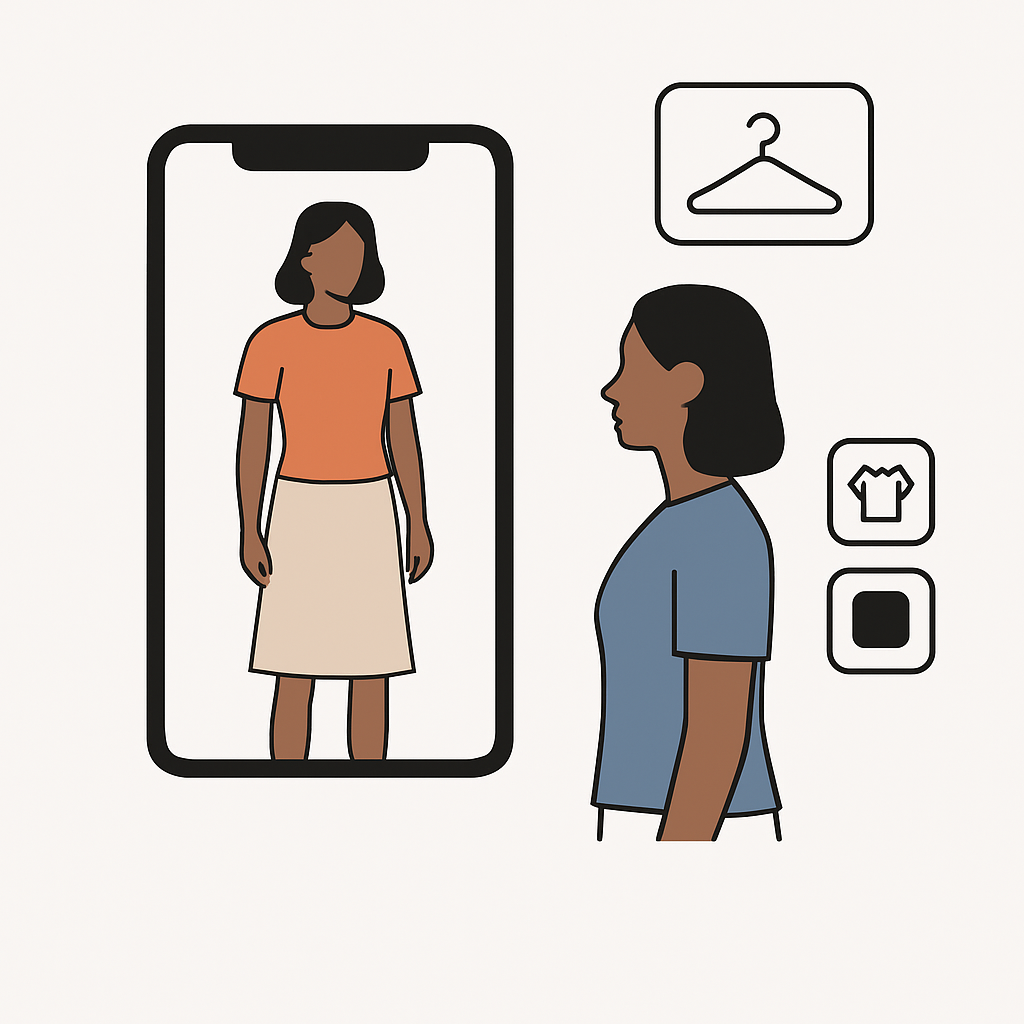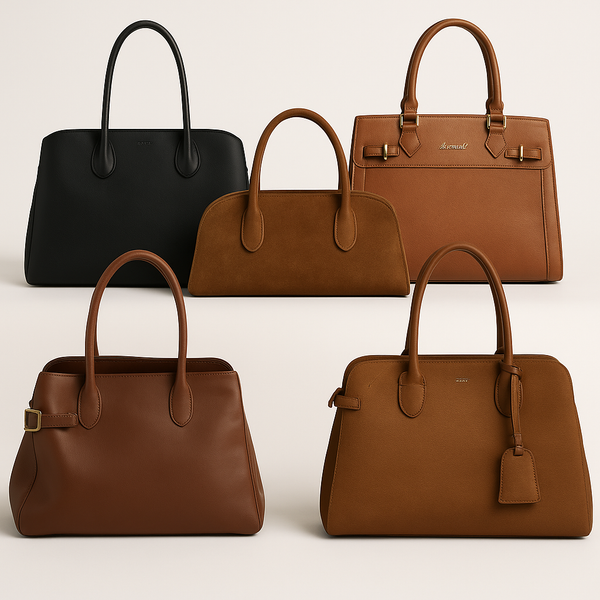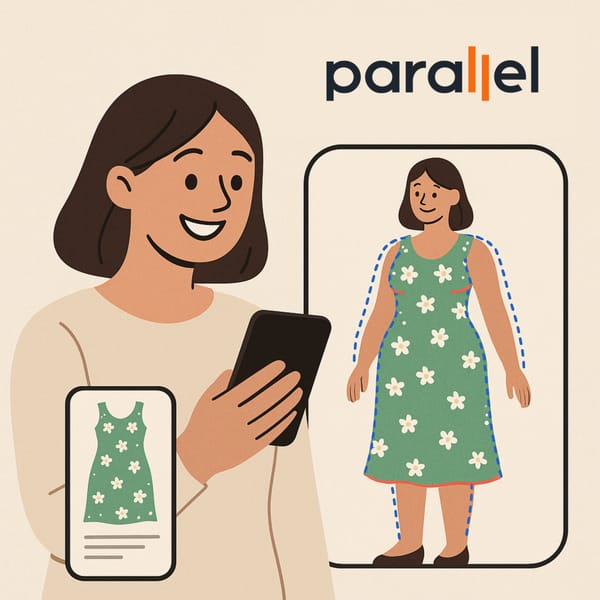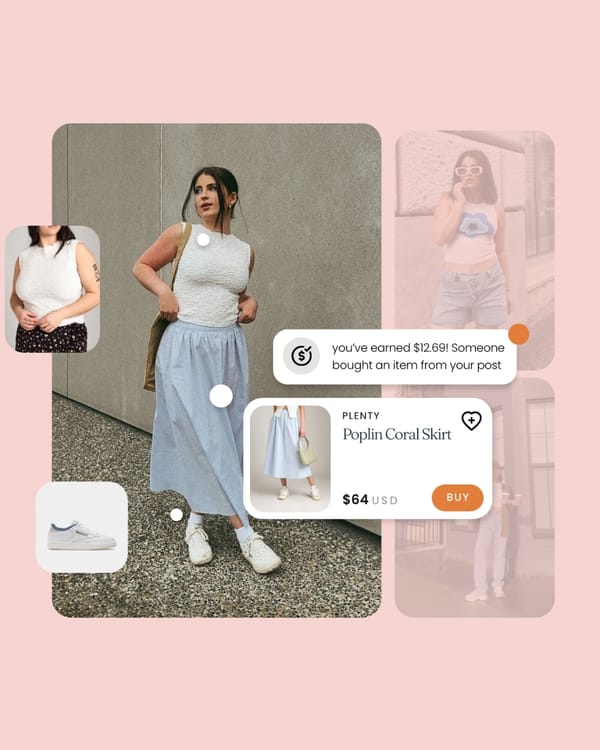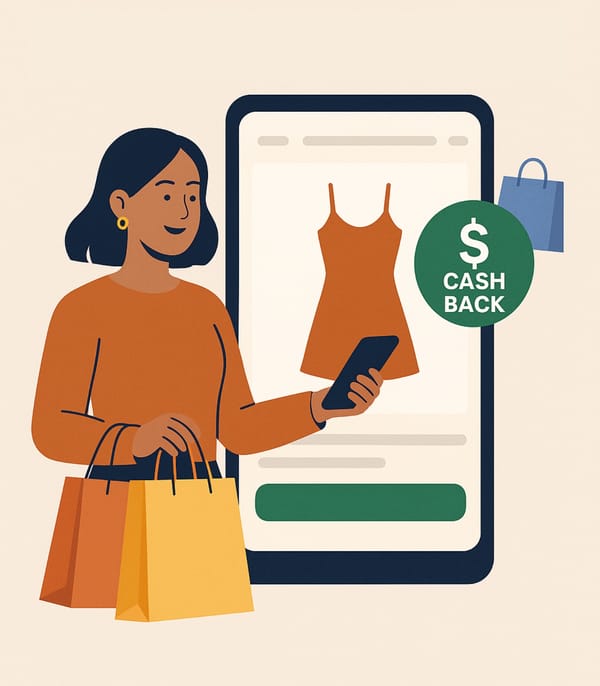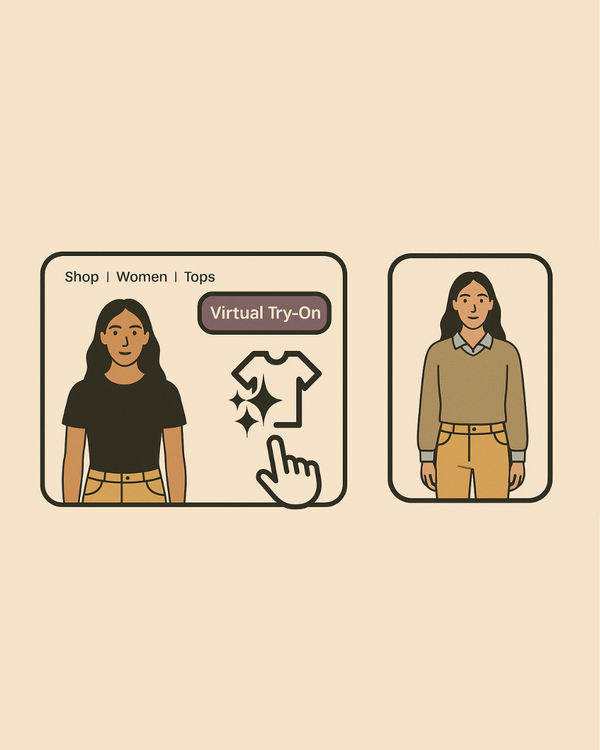The online shopping experience is transforming. No longer do customers need to make a leap of faith when purchasing clothing; a new wave of AI and augmented reality technology is enabling them to see exactly how items will look on their own bodies before hitting the checkout button.
Virtual fitting rooms and try-on features have evolved from a novelty into an essential shopping tool, and the market is responding. The global virtual fitting room market is projected to grow from $6.86 billion in 2025 to $24.30 billion by 2032, representing a compound annual growth rate of 19.8%. This explosive growth signals that both retailers and consumers are embracing this technology as a game-changer in how we shop online.
How Virtual Try-On Technology Works
The Technical Explination
Modern virtual try-on uses AI and computer vision to create a personalized shopping experience that was impossible just a few years ago.
At its core, virtual try-on technology relies on two primary approaches: augmented reality (AR) and artificial intelligence (AI). Most virtual fitting rooms use augmented reality, where a webcam scans a person's body to create a 360-degree 3D model. Some are powered by artificial intelligence, which uses algorithms and machine learning to take body measurements and create full-body 3D models of the shopper standing in front of the camera.
The 3D model created by AI or AR is combined with radio frequency identification (RFID), which scans the products a shopper has taken to the virtual fitting room. Virtual reality technology then overlays the scanned products on the 3D model of the shopper, allowing them to see what they look like wearing an item without physically trying it on.
The result is an intuitive, accessible technology that doesn't require expensive equipment or complicated software.
The Simple Explination
You upload one full-body photo where you're standing naturally. The AI analyzes your body shape, proportions, and features—not to judge, but to understand how different garments will sit, drape, and look on your specific frame.
From that single photo, you can now try on thousands of eligible clothing items virtually. Within seconds, you see a realistic visualization of yourself wearing that exact piece. Not an avatar. Not an approximation. You, in that outfit.
The technology preserves your natural shape and proportions while accurately rendering how different styles, colors, and cuts will look. Want to see how that dress looks in three different colors? Done. Curious if an oversized sweater or fitted blazer suits you better? Compare them side by side.
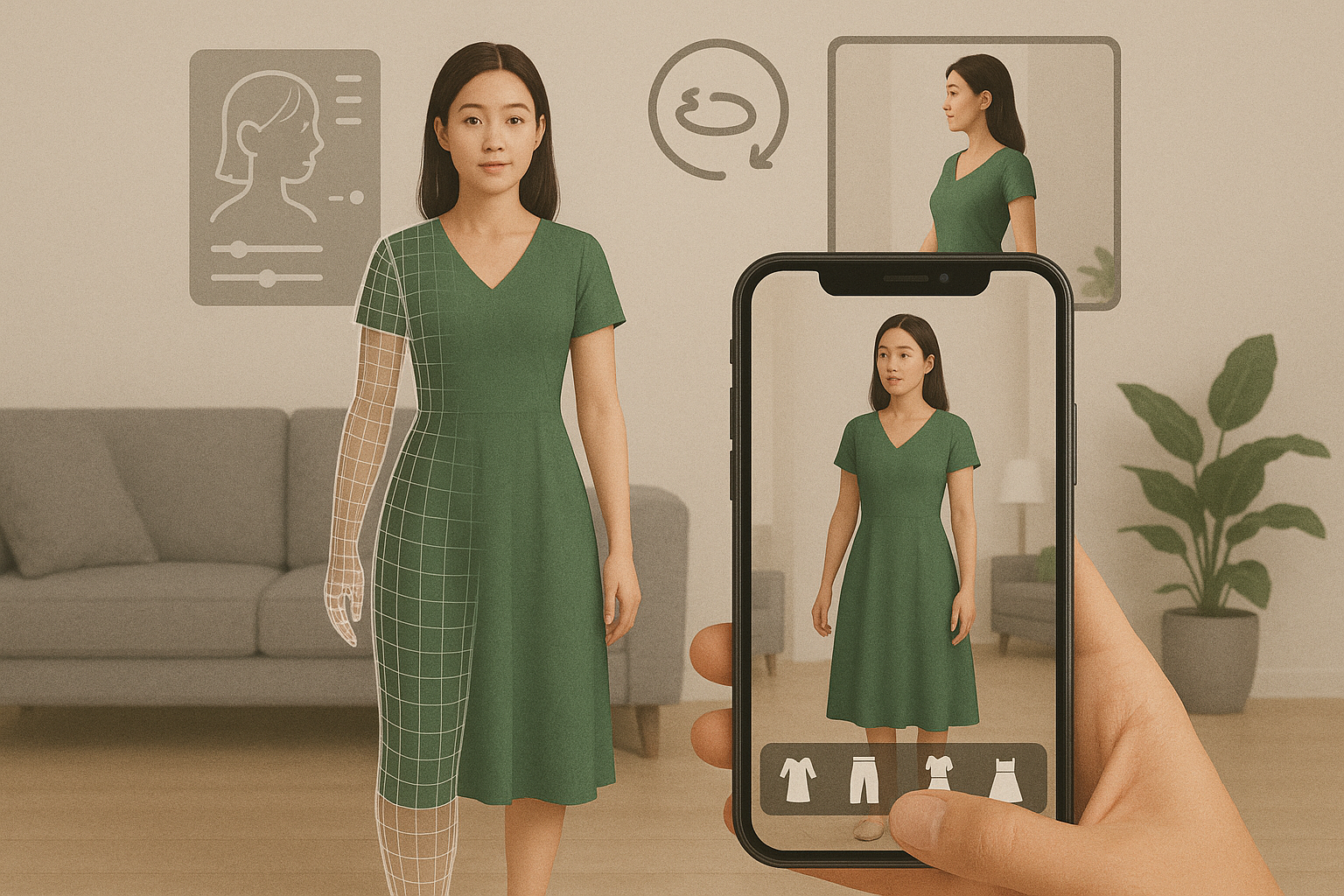
What makes modern virtual try-on different from earlier attempts
Accuracy: Advanced AI can now capture dozens of body measurements and nuances that affect how clothes fit and look, creating visualizations that actually match reality.
Speed: Results appear in under 10 seconds, making the experience feel seamless rather than tedious.
Variety: Thousands of items across categories—tops, bottoms, dresses, full-body garments—are now compatible with virtual try-on technology.
Personalization: The technology adapts to your reference photo, not a generic mannequin or standardized avatar.
The Problem Virtual Try-On Solves
Online fashion shopping has always required an uncomfortable leap of faith. You're making expensive decisions with incomplete information, hoping that what looks good on a professional model will somehow translate to your body, your proportions, your life.
The questions that haunt every online clothing purchase:
- Can I pull off this style?
- Will this suit my body type?
- Does this color work with my skin tone?
- How does this look with my other favorite pieces?
The result of this uncertainty is staggering: fashion e-commerce return rates hover around 30-40%, with some categories reaching even higher. That's billions of dollars in returned merchandise, millions of hours wasted on return processes, and an environmental footprint that's completely unsustainable.
Virtual try-on technology attacks this problem at its root. Instead of guessing how clothes will look on you, you simply see it—immediately, accurately, personally.

Hate Returning Clothes?
Get smart size recommendations & see how clothes look on real people before you buy. Only on Parallel.
AI Size RecommenderParallel's Virtual Try-On
In a significant move to enhance the online shopping experience, Parallel has launched its Virtual Try-On feature, bringing this powerful technology directly to consumers. The approach is straightforward and user-focused: shoppers upload a single full-body photo, and the AI instantly generates realistic visualizations of thousands of eligible clothing items from their favorite brands.
Parallel's Virtual Try-On uses AI to instantly show customers how clothes look on their actual body. After uploading one full-body photo to their account, users are ready to virtually try on thousands of eligible items from favorite brands, with no need to wonder if that dress will flatter their shape or if those jeans will work with their style.
The feature addresses one of the most common pain points of online shopping: the disconnect between how clothes look on models versus how they'll actually fit your unique body type. Unlike most virtual try-on tech that shows clothes on idealized bodies, Parallel's feature uses customers' actual shapes, shoulders, proportions, and vibe.

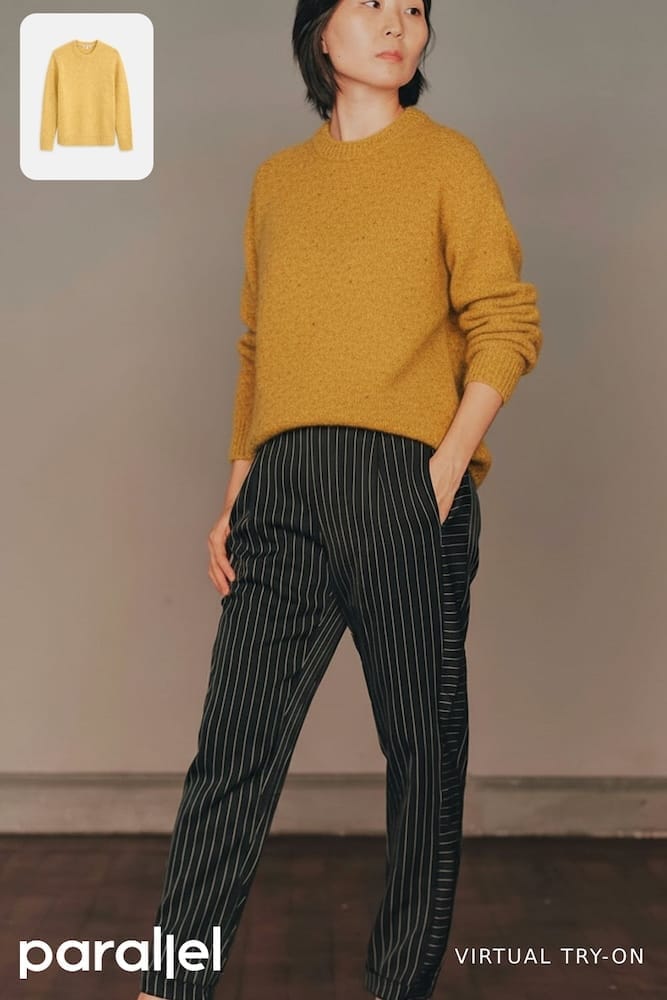
How to Use Parallel's Virtual Try-On
Getting started is remarkably simple. First, users upload a full-body photo where they're standing naturally. Then, they browse for items marked with the Virtual Try-On badge while shopping favorite brands. Tapping the Virtual Try-On icon triggers AI to generate a realistic image of the user in that exact item, with results appearing in under 20 seconds. Users can then experiment with different colors and styles, or share their try-on images with friends for feedback.
What sets Parallel apart is the integration of social feedback. Each virtual try-on has its own comments section where friends can leave feedback before a purchase is made. This transforms online shopping from a solitary experience into a collaborative one, mimicking the tried-and-true approach of shopping with friends in physical stores.
The Real Value: Confidence and Experimentation
Beyond the technical capabilities, Parallel's Virtual Try-On delivers something more fundamental: confidence. Customers can shop with confidence rather than guesswork, seeing exactly how garments look on their real body before spending money. They can also try bold styles risk-free, experimenting with patterns or silhouettes they'd never dare try in a fitting room, with no commitment, returns, or hassle of traditional fitting rooms.
For serial returners, those who've gotten used to ordering multiple sizes and returning what doesn't fit, this technology is transformative. By visualizing the fit before purchase, customers can break the cycle of excessive returns and make smarter shopping decisions on the first try.
The Future of Virtual Try-Ons
As the technology continues to advance, we can expect even more sophisticated features. Real-time rendering improvements will make visualizations increasingly indistinguishable from reality. AI will become smarter at predicting how specific fabrics will drape based on body type. Integration with sizing data will help eliminate fitting issues.
Importantly, Parallel's Virtual Try-On works seamlessly with its cashback program, allowing users to visualize first and earn rewards when they buy. This integration of try-on technology with incentive programs represents the next evolution: making virtual try-ons not just a convenient shopping tool, but a rewarding one.
Conclusion: The Shift is Happening Now
Virtual try-on technology has moved from the realm of luxury retail experimentation into mainstream adoption. The combination of AI advancement, reduced return rates, and improved customer satisfaction makes it clear that this is no longer a "nice-to-have" feature; it's becoming a competitive necessity.
Parallel's launch of Virtual Try-On demonstrates how this technology can be implemented in a user-friendly, accessible way that prioritizes the actual customer experience. By focusing on realism, social integration, and ease of use, Parallel is showing that virtual try-ons don't need to be complicated to be effective.
For online fashion retailers, the question is no longer whether to implement virtual try-on technology, but how quickly they can do so. For shoppers, the future of online clothing shopping has finally arrived: the ability to see yourself in it before you buy it.
Frequently Asked Questions
What exactly is a virtual try-on?
A virtual try-on is an AI-powered feature that lets you upload a photo of yourself and see how clothing items will look on your actual body before purchasing. Instead of relying on photos of models, you get a personalized visualization of how the item fits your unique shape and proportions.
How accurate are virtual try-ons?
Modern virtual try-on technology is highly accurate for visualizing style and fit. The AI creates realistic visualizations that preserve your natural shape and proportions. However, factors like fabric drape may vary slightly from the actual item. If you're not satisfied with the first result, most systems allow you to generate alternate versions.
Do I need special equipment to use virtual try-ons?
No. You simply need a smartphone or a camera to upload a full-body photo. The entire process happens through your web browser or mobile app, no special equipment required.
What kind of photo should I upload?
For best results, use a full-body photo taken with natural lighting where you're standing naturally with relaxed arms. Make sure only you are in the frame and your body shape is clearly visible.
Is my photo kept private?
Yes. Your photo is stored securely in your account and is never shared with brands, other users, or third parties. You can delete it anytime from your profile settings.
Can I share my virtual try-on results with friends?
Absolutely. You can download your try-on images, share them via social media or text, and get feedback from friends before making a purchase decision.
How much does virtual try-on technology cost?
Virtual Try-Ons are currently free on Parallel! Try-Ons are limited to 20 per day.
Does using virtual try-on affect my ability to earn rewards or cashback?
No. Virtual try-on features work seamlessly alongside existing reward programs, so you can visualize your purchase and earn rewards when you buy.
Why do some items have the Virtual Try-On badge and others don't?
Retailers gradually roll out virtual try-on compatibility for their products. Currently, thousands of items across categories like tops, bottoms, dresses, and full-body garments are eligible. More items are being added continuously.
Will virtual try-ons completely replace physical fitting rooms?
While virtual try-ons significantly reduce the need for physical fitting rooms and the space they require, they complement rather than completely replace the in-store experience. Many retailers are using both options to serve different customer preferences.



